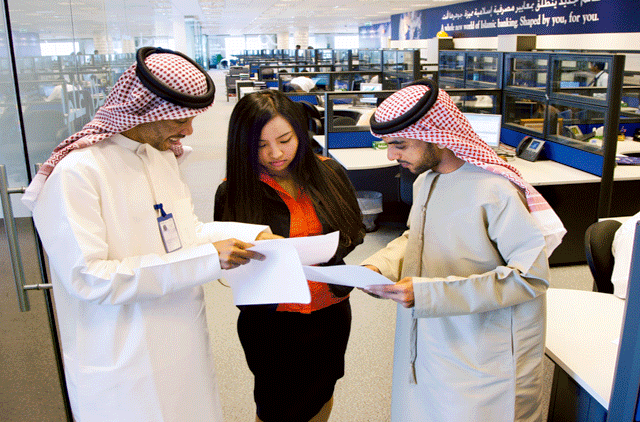
The demand and supply of newer, more complex products across sectors is fuelling the growth of Islamic finance assets, which are expected to reach a total of $2.1 trillion (Dh7.7 trillion) globally by the end of this year. The estimate comes from KFH-Research, a subsidiary of Kuwait Finance House Group. However, the world over, this growth only underpins the urgency for a regulatory framework, which will enable creation of products with clear Islamic and financial credentials.
Double-digit growth
KFH-Research’s Islamic Finance Outlook 2014 forecasts that the industry will continue to generate double-digit growth rates across all sectors, including takaful (insurance) and sukuk (financial certificates, the Islamic alternative to bonds). It put Islamic finance assets at $1.8 trillion in 2013, representing a 16 per cent year-on-year growth.
From London to Kenya and the UAE, Islamic finance is taking giant strides. Dubai Islamic Bank, the emirate’s largest Sharia-compliant lender, recently announced plans to expand its operations into Indonesia, Kenya and other African countries. Analysts say Saudi Arabia, Malaysia, Bahrain and Qatar are other rapid growth markets.
“The demand is ultimately from the consumer. For example, there are very few banks that proffer genuine Islamic working capital financing arrangements for SMEs. So there is a real need there to have some sort of Islamic facility for this sector,” says Oliver Agha, Managing Partner of Agha & Co, a boutique legal consultancy focusing on Islamic finance and financial advisory.
His company is currently working on two new products — a new sukuk structure with Islamic Development Bank (IDB) and a product for SME financing, to be released in the next six months.
It was only a few years ago that we saw Islamic banking windows crop up in most conventional banks, made possible by software development that enables the creation of Islamic modules within the larger core system and doing away with the necessity of creating separate work spaces. “The biggest trend is the growing acceptability. More and more products are being added into Islamic banking, bringing it on par with traditional banks. There are now more comparable products,” says Vivek Agarwal, Senior Vice President and Business Head for the analytics and technology solutions for business information company Dun & Bradstreet in the Middle East, Africa and South Asia.
Recent years have seen Islamic banking products compete with retail and corporate banking, especially in core Islamic countries. It is usual now for a consumer to consider an Islamic finance option when buying a car or a home, for instance, choosing one product over the other purely on merit.
“ADIB has recently launched a salary bonus scheme specifically designed to appeal to our growing expatriate customer base. This is our first mass-market product and includes many features suited to Muslim and non-Muslim customers alike. In the coming year we are also planning to launch a new product to cater to a growing demand for a pension-based savings plan, as well as additional investment products,” says Philip King, Head of Retail Banking — UAE, ADIB.
Critical challenges
There is general agreement in the industry that regulatory benchmarks, comprising a dispute resolution centre and a Central Sharia Board, are the next frontier for most strong Islamic markets.
Currently, most banks rely on boards comprising groups of scholars, who rule on whether financial instruments and activities are religiously permissible. “Standardisation is a critical challenge facing Islamic finance because until you have regulations that govern how you develop, build and structure products there will be over-reliance on a board, where you sometimes may get very different opinions on the same product,” says Agha.
Agha, whose company advises a large chunk of the UAE’s Islamic banks, says with growing popularity comes an increasing number of disagreements — although none are major yet. “When I first started in Islamic finance over a decade ago there were no disputes. Five years into it, there were a few scattered disputes. Now we see significant disputes,” he says.
Accelerating efforts
The need is felt worldwide. Dr Zeti Akhtar Aziz, Governor, Bank Negara Malaysia in her Islamic Development Bank (IDB) Prize Lecture, in Jeddah in November last year spoke of “the need to accelerate efforts to further strengthen
the infrastructural underpinnings for the development of
the overall Islamic financial system”.
In fact, lack of a clear, independent regulatory structure affects the richness of products that can be offered under the system. Warning of “unintended consequences”, Dr Aziz says that “Islamic banks today continue to be confronted with limitations in the availability of a sufficiently deep and diverse pool of Sharia-compliant instruments — in both domestic and international currencies — in which they can invest. Under the strengthened international capital and liquidity standards, this can result in higher costs of compliance, inefficiencies in funding structures and increased risks of funding mismatches.”
Banks are already driven to reassess, and the consumer is no longer satisfied with the same old product with a few tweaks and a new name. “I have seen an increase in demand for developing genuinely Sharia-compliant structures. There is already very strong review by some of the leading banks to reconsider their product organisation, documentation and structures because many of their cases have gone to court,” says Agha. “They are trying to rejig their contractual arrangements, so in the future when they go to courts they are better off by having enforceable structures not just purportedly Sharia-compliant ones.”








